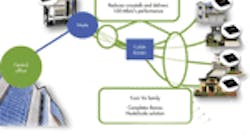The Ikanos Fusiv Vx processors implement unique algorithms to reduce crosstalk and adaptively reduce noise on the DSL UTP lines to deliver 100-Mbit/s data at one-tenth the cost of fiber. Such cancellation takes place on lines between the DSLAM node and the cable binder that distributes the lines to the neighborhood homes and then on the lines to the homes.
DSL is the high-speed interconnection of choice for many consumers in the U.S., as well as most of Europe and Asia. Speeds are generally high enough for the usual Web surfing and e-mail. Data speeds vary with the Internet Service Provider (ISP) but run from about 6 to 10 Mbits/s max. Cable TV connections dominate in the U.S. and typically can deliver speeds up to 50 Mbits/s.
But now that more video is being delivered over the Internet connection, higher speeds are needed for those ISPs trying to upgrade their systems. The goal is to avoid building out a fiber network, which can cost as much as $2500 per connection compared to only about $250 for the average home connection using the traditional unshielded twisted pair (UTP) that most homes have. Ikanos has a solution for that.
The Ikanos Fusiv Vx185/183 communications processors are designed to implement super-fast DSL in customer premise equipment (CPE) like gateways, routers, and set-top boxes. These processors implement NodeScale Vectoring, which is based on the ITU’s recent G.993.5 standard. Also called G.vector, this standard defines a technology that reduces noise and crosstalk on the UTP.
Homes are connected to the ISP by way of telephone cable that, for decades, has been in the ground or on a pole in most cases. It still works great if you’re using DSL, but even DSL has its limitations. DSL has evolved over the years from the basic ADSL of the late 1990s to the ADSL2 and VDSL2 used today.
DSL uses a form of orthogonal frequency division multiplexing (OFDM) called discrete multitone (DMT). Its later versions add subcarriers way out to 30 MHz. At these frequencies, noise begins to become more of a factor influencing performance. The crosstalk between the pairs in the cable also seriously limits performance. This results in slower data speeds, as well as reduced distance on the cable.
Up until recently, speeds of up to about 50 Mbits/s were possible over a few thousand feet of UTP before crosstalk and noise killed the signal. Now with NodeScale Vectoring, ISPs can upgrade their neighborhood digital subscriber line access multiplexers (DSLAMs), as well as the CPE boxes, to get up to 100-Mbit/s rates.
The Ikanos processors are designed to detect the noise and crosstalk and then communicate over the DSL back channel with their DSLAM equivalents. The processors then go to work to cancel the noise and crosstalk using a procedure not unlike that used in noise-cancelling headphones. An equal and opposite signal is generated, and the two are added together to get a high degree of cancellation. A lot of processing is involved with all those twisted pairs.
TheVx185 and Vx183 are two chipset processors that include a MIPS 34K multi-threaded 500-MHz processor, ADSL2, and VDSL2 30a support for an integrated front-end. There are two Ethernet media access controllers (MACs) with GMII/rGMII/MII/rMII interfaces, a USB 2.0 port, PCI Express 1.1 two-lane, and DDR2 memory. Other standard interfaces include GPIO, UART, SPI, I2C, and SCU.
These chipsets also support all wired networking technologies including HomePNA, HomePlug, Muitimedia Over Coax, and ITU G.hn. Both processors have 802.11n dual-band Wi-Fi built in as well as four channels of integrated voice DSP. Both IPSec and SSL VPN are implemented with on-chip crypto engines. And, both support Linux and BSP operating systems.
Additional features on the Vx185 include VPN security and VDSL2/ADSL2 channel bonding that combines two twisted pairs to boost speed to 180 Mbits/s or more over a short link. The Vx185 also has a SATA/eSATA controller and interface.
The new ITU standard and these Ikanos processors promise to give much longer life to DSL systems and help ISPs hold down costs to stay competitive in the broadband space.
Ikanos Communications Inc.
www.ikanos.com


